2008 KIA Sedona center console
[x] Cancel search: center consolePage 12 of 339
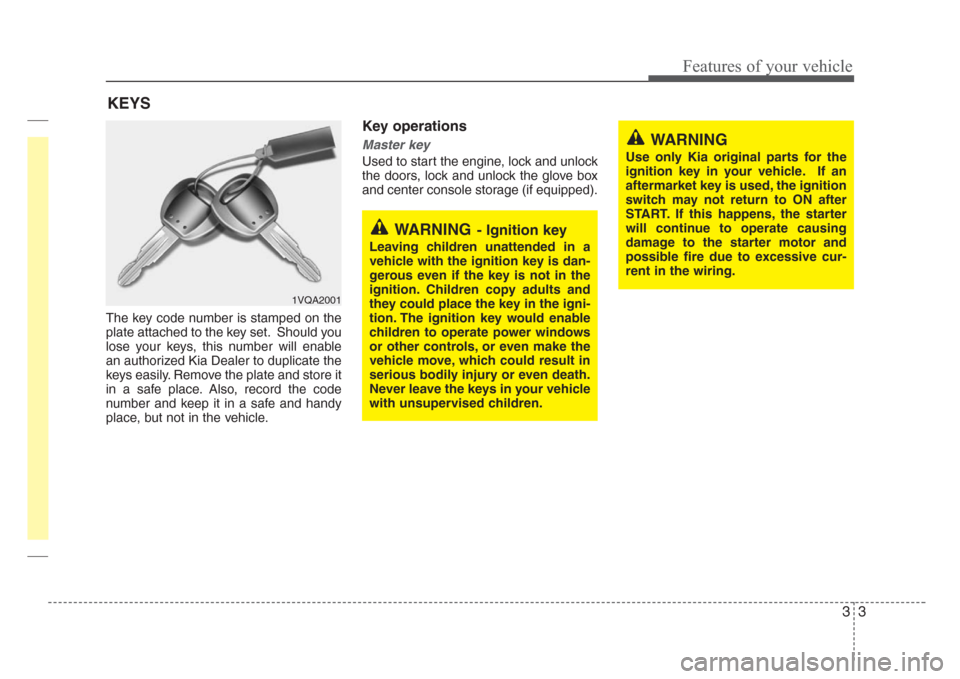
33
Features of your vehicle
The key code number is stamped on the
plate attached to the key set. Should you
lose your keys, this number will enable
an authorized Kia Dealer to duplicate the
keys easily. Remove the plate and store it
in a safe place. Also, record the code
number and keep it in a safe and handy
place, but not in the vehicle.
Key operations
Master key
Used to start the engine, lock and unlock
the doors, lock and unlock the glove box
and center console storage (if equipped).
KEYS
WARNING- Ignition key
Leaving children unattended in a
vehicle with the ignition key is dan-
gerous even if the key is not in the
ignition. Children copy adults and
they could place the key in the igni-
tion. The ignition key would enable
children to operate power windows
or other controls, or even make the
vehicle move, which could result in
serious bodily injury or even death.
Never leave the keys in your vehicle
with unsupervised children.
1VQA2001
WARNING
Use only Kia original parts for the
ignition key in your vehicle. If an
aftermarket key is used, the ignition
switch may not return to ON after
START. If this happens, the starter
will continue to operate causing
damage to the starter motor and
possible fire due to excessive cur-
rent in the wiring.
Page 26 of 339
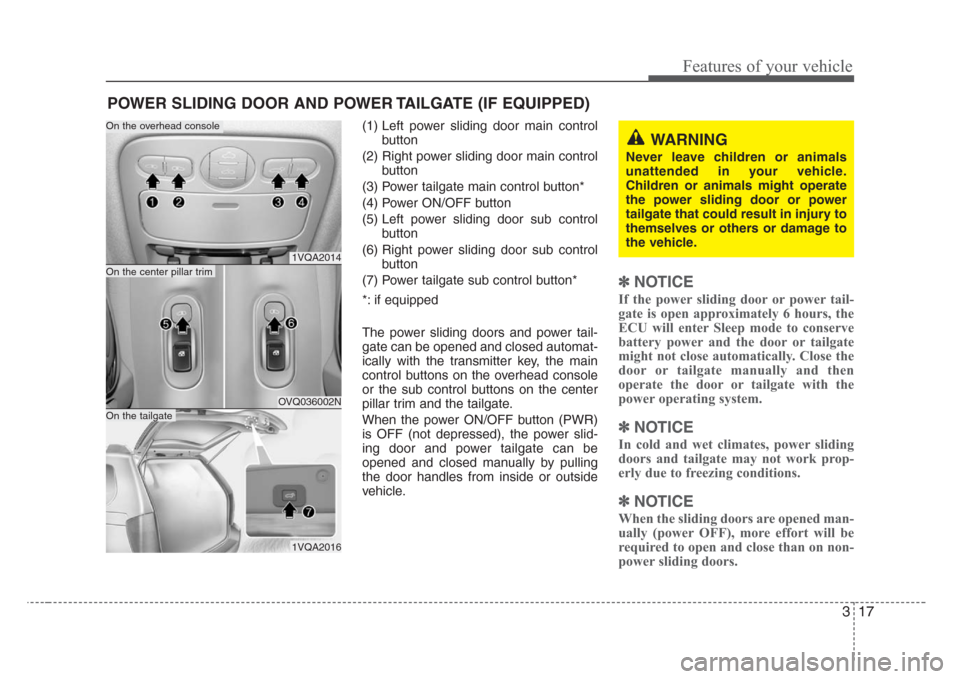
317
Features of your vehicle
(1) Left power sliding door main control
button
(2) Right power sliding door main control
button
(3) Power tailgate main control button*
(4) Power ON/OFF button
(5) Left power sliding door sub control
button
(6) Right power sliding door sub control
button
(7) Power tailgate sub control button*
*: if equipped
The power sliding doors and power tail-
gate can be opened and closed automat-
ically with the transmitter key, the main
control buttons on the overhead console
or the sub control buttons on the center
pillar trim and the tailgate.
When the power ON/OFF button (PWR)
is OFF (not depressed), the power slid-
ing door and power tailgate can be
opened and closed manually by pulling
the door handles from inside or outside
vehicle.
✽
NOTICE
If the power sliding door or power tail-
gate is open approximately 6 hours, the
ECU will enter Sleep mode to conserve
battery power and the door or tailgate
might not close automatically. Close the
door or tailgate manually and then
operate the door or tailgate with the
power operating system.
✽
NOTICE
In cold and wet climates, power sliding
doors and tailgate may not work prop-
erly due to freezing conditions.
✽
NOTICE
When the sliding doors are opened man-
ually (power OFF), more effort will be
required to open and close than on non-
power sliding doors.
POWER SLIDING DOOR AND POWER TAILGATE (IF EQUIPPED)
1VQA2014
OVQ036002N
1VQA2016
On the center pillar trim
On the tailgate
On the overhead console
WARNING
Never leave children or animals
unattended in your vehicle.
Children or animals might operate
the power sliding door or power
tailgate that could result in injury to
themselves or others or damage to
the vehicle.
Page 29 of 339
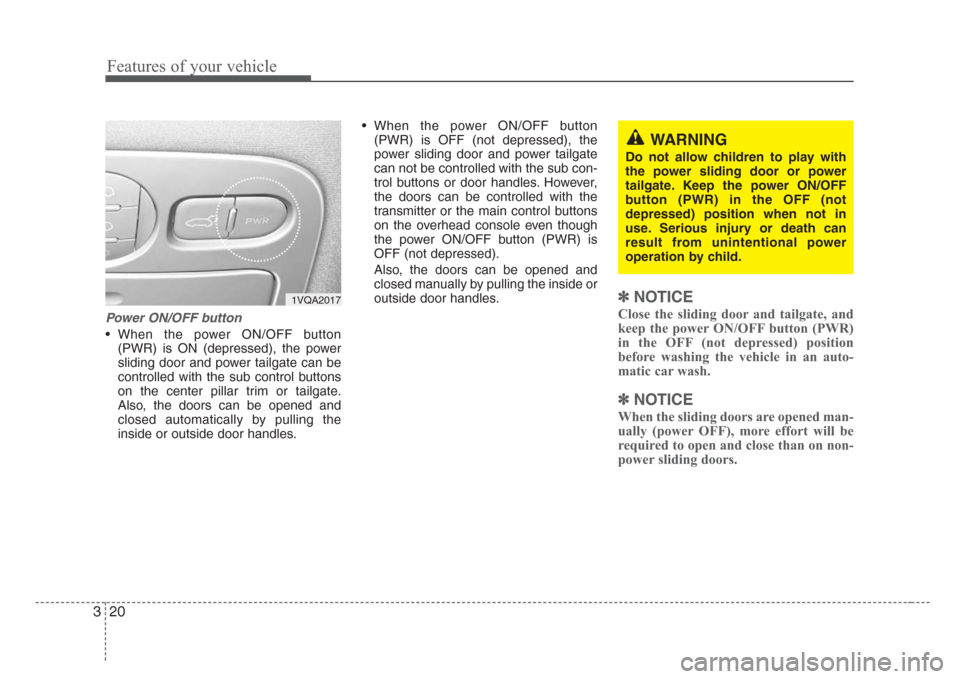
Features of your vehicle
20 3
Power ON/OFF button
• When the power ON/OFF button
(PWR) is ON (depressed), the power
sliding door and power tailgate can be
controlled with the sub control buttons
on the center pillar trim or tailgate.
Also, the doors can be opened and
closed automatically by pulling the
inside or outside door handles.• When the power ON/OFF button
(PWR) is OFF (not depressed), the
power sliding door and power tailgate
can not be controlled with the sub con-
trol buttons or door handles. However,
the doors can be controlled with the
transmitter or the main control buttons
on the overhead console even though
the power ON/OFF button (PWR) is
OFF (not depressed).
Also, the doors can be opened and
closed manually by pulling the inside or
outside door handles.
✽
NOTICE
Close the sliding door and tailgate, and
keep the power ON/OFF button (PWR)
in the OFF (not depressed) position
before washing the vehicle in an auto-
matic car wash.
✽
NOTICE
When the sliding doors are opened man-
ually (power OFF), more effort will be
required to open and close than on non-
power sliding doors.
1VQA2017
WARNING
Do not allow children to play with
the power sliding door or power
tailgate. Keep the power ON/OFF
button (PWR) in the OFF (not
depressed) position when not in
use. Serious injury or death can
result from unintentional power
operation by child.
Page 30 of 339
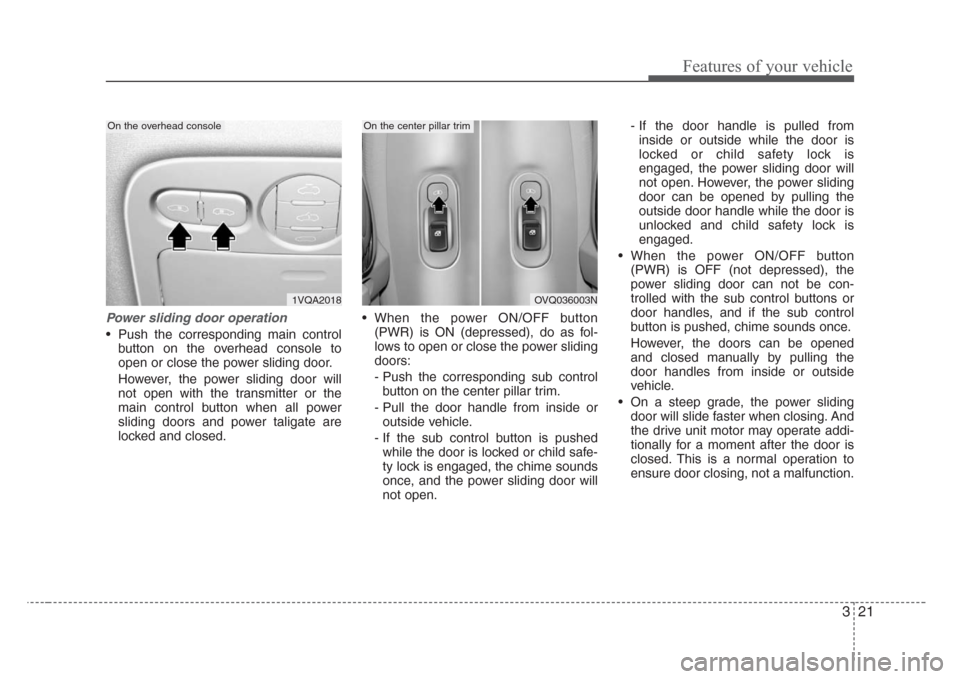
321
Features of your vehicle
Power sliding door operation
• Push the corresponding main control
button on the overhead console to
open or close the power sliding door.
However, the power sliding door will
not open with the transmitter or the
main control button when all power
sliding doors and power taligate are
locked and closed.• When the power ON/OFF button
(PWR) is ON (depressed), do as fol-
lows to open or close the power sliding
doors:
- Push the corresponding sub control
button on the center pillar trim.
- Pull the door handle from inside or
outside vehicle.
- If the sub control button is pushed
while the door is locked or child safe-
ty lock is engaged, the chime sounds
once, and the power sliding door will
not open.- If the door handle is pulled from
inside or outside while the door is
locked or child safety lock is
engaged, the power sliding door will
not open. However, the power sliding
door can be opened by pulling the
outside door handle while the door is
unlocked and child safety lock is
engaged.
• When the power ON/OFF button
(PWR) is OFF (not depressed), the
power sliding door can not be con-
trolled with the sub control buttons or
door handles, and if the sub control
button is pushed, chime sounds once.
However, the doors can be opened
and closed manually by pulling the
door handles from inside or outside
vehicle.
• On a steep grade, the power sliding
door will slide faster when closing. And
the drive unit motor may operate addi-
tionally for a moment after the door is
closed. This is a normal operation to
ensure door closing, not a malfunction.
1VQA2018
On the overhead console
OVQ036003N
On the center pillar trim
Page 90 of 339
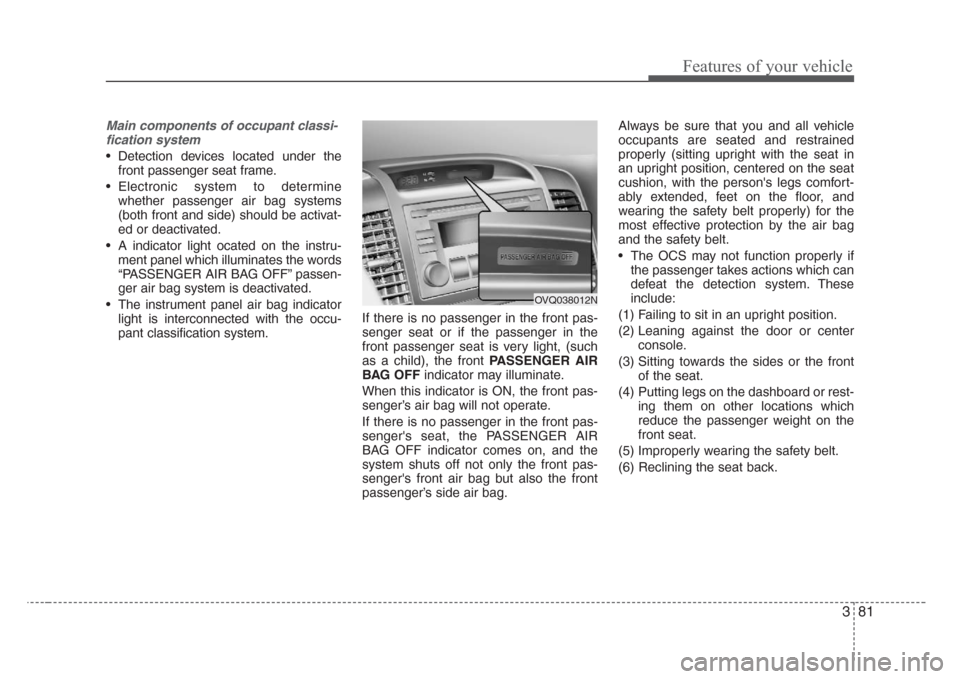
381
Features of your vehicle
Main components of occupant classi-
fication system
• Detection devices located under the
front passenger seat frame.
• Electronic system to determine
whether passenger air bag systems
(both front and side) should be activat-
ed or deactivated.
• A indicator light ocated on the instru-
ment panel which illuminates the words
“PASSENGER AIR BAG OFF” passen-
ger air bag system is deactivated.
• The instrument panel air bag indicator
light is interconnected with the occu-
pant classification system.If there is no passenger in the front pas-
senger seat or if the passenger in the
front passenger seat is very light, (such
as a child), the front PASSENGER AIR
BAG OFFindicator may illuminate.
When this indicator is ON, the front pas-
senger’s air bag will not operate.
If there is no passenger in the front pas-
senger's seat, the PASSENGER AIR
BAG OFF indicator comes on, and the
system shuts off not only the front pas-
senger's front air bag but also the front
passenger’s side air bag.Always be sure that you and all vehicle
occupants are seated and restrained
properly (sitting upright with the seat in
an upright position, centered on the seat
cushion, with the person's legs comfort-
ably extended, feet on the floor, and
wearing the safety belt properly) for the
most effective protection by the air bag
and the safety belt.
• The OCS may not function properly if
the passenger takes actions which can
defeat the detection system. These
include:
(1) Failing to sit in an upright position.
(2) Leaning against the door or center
console.
(3) Sitting towards the sides or the front
of the seat.
(4) Putting legs on the dashboard or rest-
ing them on other locations which
reduce the passenger weight on the
front seat.
(5) Improperly wearing the safety belt.
(6) Reclining the seat back.
OVQ038012N
Page 93 of 339
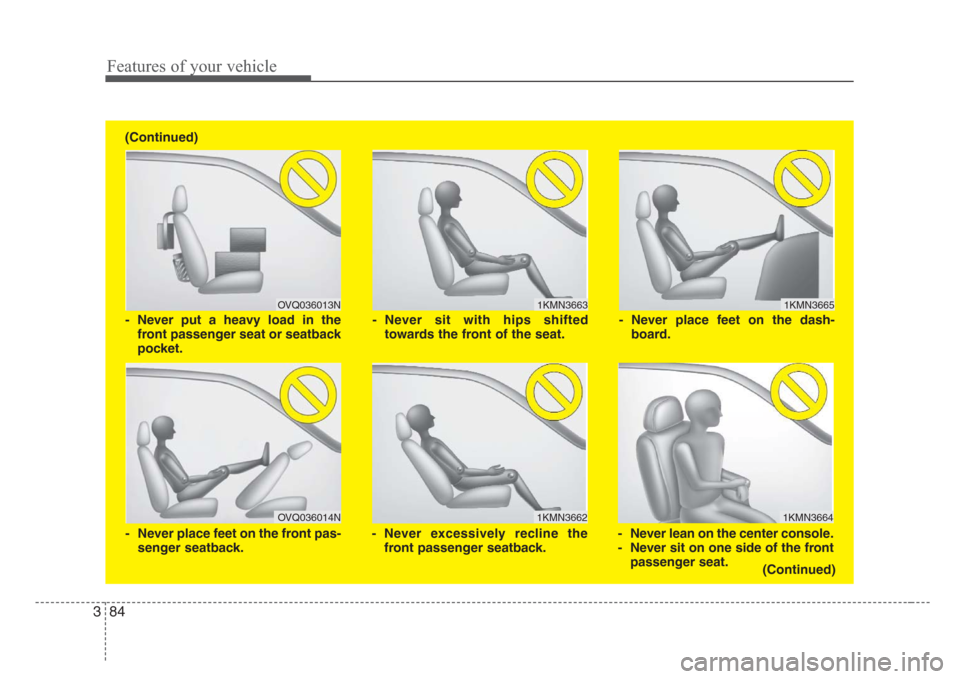
Features of your vehicle
84 3
1KMN3663
1KMN3664
1KMN3665
- Never sit with hips shifted
towards the front of the seat.
- Never lean on the center console.
- Never sit on one side of the front
passenger seat. - Never place feet on the dash-
board.
(Continued)
OVQ036013N
1KMN3662
- Never put a heavy load in the
front passenger seat or seatback
pocket.
- Never excessively recline the
front passenger seatback.
OVQ036014N
- Never place feet on the front pas-
senger seatback. (Continued)
Page 108 of 339
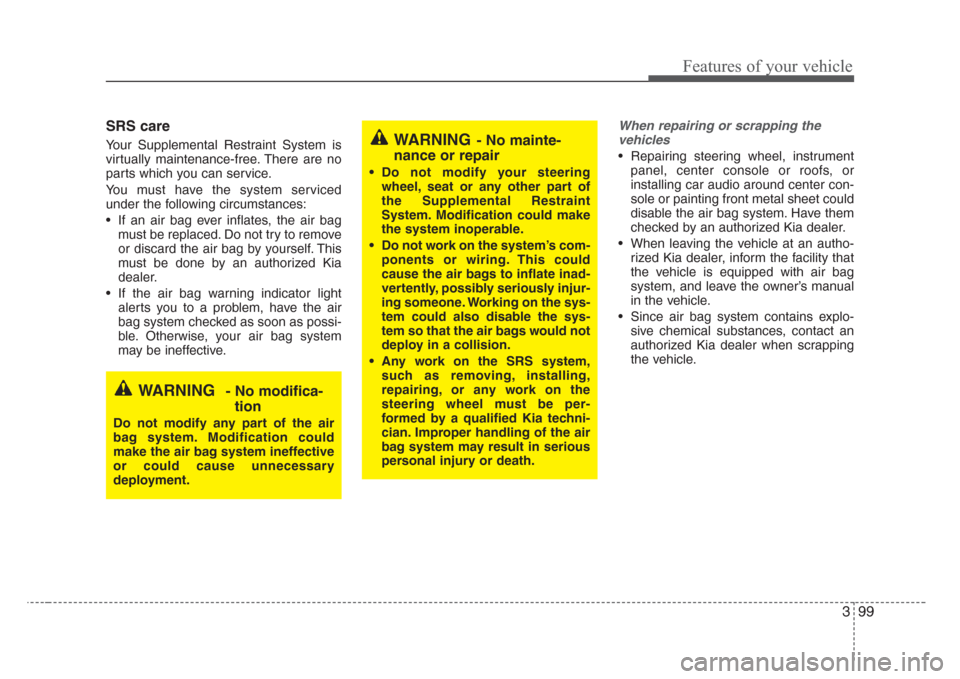
399
Features of your vehicle
SRS care
Your Supplemental Restraint System is
virtually maintenance-free. There are no
parts which you can service.
You must have the system serviced
under the following circumstances:
• If an air bag ever inflates, the air bag
must be replaced. Do not try to remove
or discard the air bag by yourself. This
must be done by an authorized Kia
dealer.
• If the air bag warning indicator light
alerts you to a problem, have the air
bag system checked as soon as possi-
ble. Otherwise, your air bag system
may be ineffective.
When repairing or scrapping the
vehicles
• Repairing steering wheel, instrument
panel, center console or roofs, or
installing car audio around center con-
sole or painting front metal sheet could
disable the air bag system. Have them
checked by an authorized Kia dealer.
• When leaving the vehicle at an autho-
rized Kia dealer, inform the facility that
the vehicle is equipped with air bag
system, and leave the owner’s manual
in the vehicle.
• Since air bag system contains explo-
sive chemical substances, contact an
authorized Kia dealer when scrapping
the vehicle.
WARNING- No mainte-
nance or repair
• Do not modify your steering
wheel, seat or any other part of
the Supplemental Restraint
System. Modification could make
the system inoperable.
• Do not work on the system’s com-
ponents or wiring. This could
cause the air bags to inflate inad-
vertently, possibly seriously injur-
ing someone. Working on the sys-
tem could also disable the sys-
tem so that the air bags would not
deploy in a collision.
• Any work on the SRS system,
such as removing, installing,
repairing, or any work on the
steering wheel must be per-
formed by a qualified Kia techni-
cian. Improper handling of the air
bag system may result in serious
personal injury or death.
WARNING- No modifica-
tion
Do not modify any part of the air
bag system. Modification could
make the air bag system ineffective
or could cause unnecessary
deployment.
Page 144 of 339

3 135
Features of your vehicle
The defroster heats the window to
remove frost, fog and thin ice from the
interior and exterior of the rear window,
while engine is running.To activate the rear window defroster,
press the rear window defroster button
located in the center console switch
panel. The indicator on the rear window
defroster button illuminates when the
defroster is ON.
If there is heavy accumulation of snow on
the rear window, brush it off before oper-
ating the rear defroster.
The rear window defroster automatically
turns off after 20 minutes or when the
ignition switch is turned off. To turn off the
defroster, press the rear window
defroster button again.
Outside mirror defroster
(if equipped)
If your vehicle is equipped with the out-
side mirror defroster, it will be operating
at the same time when you operate the
rear window defroster.
DEFROSTER
OVQ038056N
OVQ038057N
Type A
Type B
CAUTION
• To prevent damage to the con-
ductors bonded to the inside sur-
face of the rear window, never use
sharp instruments or window
cleaners containing abrasives to
clean the window.
• If you want to defrost and defog
on the front windshield, refer to
“Windshield Defrosting and
Defogging” in this section.